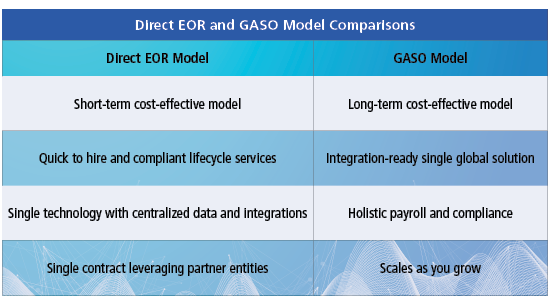 Businesses grow, and ideally, the employees who are associated with those businesses will also experience their own professional growth.
Businesses grow, and ideally, the employees who are associated with those businesses will also experience their own professional growth.
When an organization decides to go global, it also demands the flexibility to go wherever it wants to grow. Sometimes it is with a registered office/entity or sometimes it is without. What is the best way? Which is the proven path? Overall, the end goal is to ensure that the employees are paid, on time, every time.
The global HR services industry has evolved vastly and found innovative ways to provide various solutions to such growing organizations. With these innovations, combined with the implementation of modern technology in HR—such as artificial intelligence (AI), machine learning (ML), robotic process automation (RPA), and more—organizations today can provide solutions that are far more effective, valuable, and beneficial for both the employee and the employer.
Let us first look at the different ways that businesses experience growth. This includes the following:
- Organic or internal growth
- Mergers and acquisitions or external growth
- Franchising/authorization
Sure, these are conventional ways of business expansion. However, to explore the best use case, we will focus specifically on organic or internal growth.
Today’s global workforce has thoroughly adopted a “work-from-anywhere” culture. Of course, the availability of resources worldwide harmoniously compliments this culture, thereby helping the HR industry to create the following two models, which growing organizations can adopt to pay their international employees:
- Direct Employer of Record (EOR) Model
- Global Administrative Services Organization (GASO) Model
Direct EOR Model
This is a popular model among HR professionals. A Direct EOR Model enables any organization to hire and pay their employees quite literally anywhere. It provides the flexibility to expand with minimal initial investment without the need to create a registered entity or even a bank account. On behalf of the organization, the EOR partner takes care of paying the employees, dealing with employee taxes, local compliance, and other scoped needs. Whereas the “actual employer” takes care of the workers’ business deliverables and the actual job at work, all while remaining focused on the main objectives of the business.
This model works quite well for a quick ramp-up or a rapid deployment of a workforce. It can be easily implemented for special short-term projects, given that the organizations leverage employee lifecycle services offered through the partner’s in-house entities. At the same time, the various integrated HR technology offered by the EOR partner coupled with centralized data make up for an exceptional employee experience.
To sum it up, the benefits of the Direct EOR Model include the following:
- Negligible paperwork
- Negligible initial investment
- Effortlessly stay compliant across every business site globally
- No HR operations required
- Access new markets without the need for registering the business
A Direct EOR Model has a tremendous edge over a professional employer organization (PEO) and the Aggregator Model. While the PEO model does have some similarities to the EOR model, it still requires the client organization to have an entity in the country of operation. Additionally, it is also the client organization that holds the employment contract and employee insurance liability.
The Aggregator Model, on the other hand, involves multiple vendors in different geographies. Of course, involving multiple vendors generally implies decentralized data, which requires plenty of effort to control. Additionally, leveraging partner entities cannot guarantee complete employee lifecycle coverage. The Direct EOR Model addresses everything that the PEO or the Aggregator Model cannot.
GASO Model
A comparatively newer model, GASO is meant for any organizations expanding with a registered entity but with fewer than 1,000 employees and with no technology-based investment. A global organization needs to consolidate their payroll process and data centrally, yet have the flexibility to scale the solution as they grow. GASO is a partner organization that provides a blend of HR services and technology to deliver a ground-breaking HR transformation. Unlike EOR, here the organization is the actual employer and that enables the GASO partner to offer a holistic employee experience.
GASO is meant to be a cost-effective model in the long term because it includes payroll and a plethora of integrated HR technology such as time, absence, HRIS, service desk, onboarding, background checks, compliance, expense management, and many others. This means the growing organization only needs to take care of the entity registration and recruitment. The GASO partner will take care of the rest.
Benefits of the GASO Model include the following:
- Pre-configured HR technology
- Standardized and harmonized processes
- Rapid deployment with a single vendor for HR
- Leverage both payroll and HR technology in an integrated environment
- Scalable as per expansion plans
What Is Best for You?
Since we know the difference between EOR and GASO, let’s examine which model works best for your organization. This can be best answered by a quick assessment of the following factors:
- Which demographic depicts your business best?
- Is it a new organization exploring new geographies for expansion? This is typically a less than 100 employee organization.
- Is it a large organization with a presence in more than 10 countries but exploring new markets?
- Is it a global business with exponential growth that needs to take care of newer employees in different markets?
- Also, consider:
- Duration: Is the project temporary/permanent, and the engagement short-term/long-term?
- Cost: Is setting up a legal entity cost higher than managing employees? Are you spending much more on technology than the approved budget?
- Service Migration: How is change management handled? Are there delays in transition?
Once you find answers to these questions, then consider the table to determine the model that works best for you.

Finals Questions for Selection
Now that we understand the differences between the different models, here are few final key parameters to help you select the right partner:
- How is the partner compliant and updated with legislative changes in each country?
- How quickly can the partner bring the solution alive?
- Can I get a unified HR and payroll transformation?
- Is the model scalable when we go to a new country?
- How do I ensure world class employee experience?
- How can we optimize cost?
Since organizations today can provide solutions that are far more effective, valuable, and beneficial for both the employee and the employer, you’ll want to consider which model you should adopt to pay your international employees.